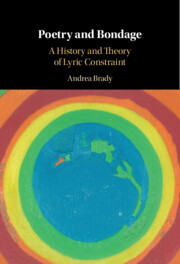Book contents
- Poetry and Bondage
- Poetry and Bondage
- Copyright page
- Dedication
- Contents
- Illustrations
- Acknowledgements
- Introduction The Fetters of Verse
- Part I Lyric Cells
- Part II The Songs of Slavery
- Chapter 5 Bind Me – I Still Can Sing
- Chapter 6 The Story that Cannot Be Told
- Chapter 7 The Sound Came from Everywhere and Nowhere
- Chapter 8 Singing at the Window
- Part III Pleasures and Ornaments
- Index
Chapter 8 - Singing at the Window
New Criticism and the Evolution of Lyric
from Part II - The Songs of Slavery
Published online by Cambridge University Press: 08 October 2021
- Poetry and Bondage
- Poetry and Bondage
- Copyright page
- Dedication
- Contents
- Illustrations
- Acknowledgements
- Introduction The Fetters of Verse
- Part I Lyric Cells
- Part II The Songs of Slavery
- Chapter 5 Bind Me – I Still Can Sing
- Chapter 6 The Story that Cannot Be Told
- Chapter 7 The Sound Came from Everywhere and Nowhere
- Chapter 8 Singing at the Window
- Part III Pleasures and Ornaments
- Index
Summary
This chapter begins with discussions of two early accounts of the sorrow songs, by the African American activist Charlotte Forten and the radical abolitionist Thomas Wentworth Higginson. These early accounts drew on both Romantic approaches to folk song and ballad and scientific or naturalist taxonomies to construct African American song-making as both historical and ahistorical. Folklorists were excited to encounter in these songs an example of a genuine ‘folk’ culture in the United States that exemplified evolutionary theories of poetic development. The chapter discusses the ‘primitive’ ballad and the ‘evolved’ lyric, and moves on to a study of the interactions between Howard Odum, a sociologist of the New South, and the Southern Agrarians, a group of scholars based at Vanderbilt University, many of whom later became part of the movement known as New Criticism. It argues that African American song is the repressed other of the New Critical idea of the lyric, and that many of those ideas are rooted in racist ideology about a pastoral, paternalistic South. It concludes with a close reading of a song whose roots can be traced to sixteenth-century England, adapted to the conditions of American chattel slavery.
Keywords
- Type
- Chapter
- Information
- Poetry and BondageA History and Theory of Lyric Constraint, pp. 246 - 280Publisher: Cambridge University PressPrint publication year: 2021

